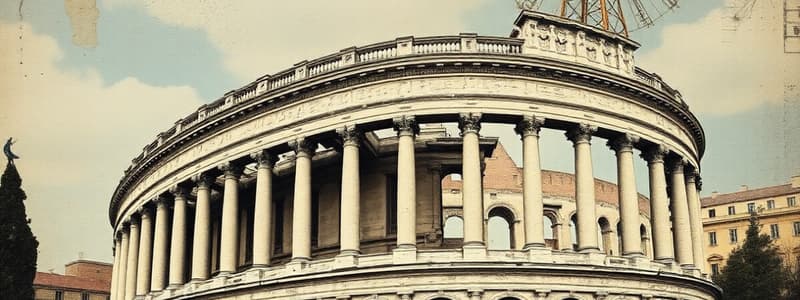Podcast
Questions and Answers
Who was the first ruler of Rome?
Who was the first ruler of Rome?
- Romulus (correct)
- Romus
- Romanus
- Remus
Which emperor initiated the construction of the Colosseum?
Which emperor initiated the construction of the Colosseum?
- Vespasian (correct)
- Nero
- Titus
- Augustus
What is the diameter of the oculus in the hemispherical dome of the Pantheon?
What is the diameter of the oculus in the hemispherical dome of the Pantheon?
- 7.10 m
- 7.90 m
- 8.10 m
- 8.90 m (correct)
What was the height and diameter of the Pantheon interior?
What was the height and diameter of the Pantheon interior?
Which type of room is a Tripadarium in Roman public baths?
Which type of room is a Tripadarium in Roman public baths?
What is the total number of entrances in the Colosseum?
What is the total number of entrances in the Colosseum?
Approximately how many public baths existed in Rome?
Approximately how many public baths existed in Rome?
What room in the Roman public baths is known as the Calidarium?
What room in the Roman public baths is known as the Calidarium?
Flashcards
Founder of Rome
Founder of Rome
Romulus was the founder and first ruler of Rome.
Pantheon Architect
Pantheon Architect
Marcus Agrippa designed and built the Pantheon.
Colosseum Initiator
Colosseum Initiator
Emperor Vespasian initiated the construction of the Colosseum.
Pantheon Oculus
Pantheon Oculus
Signup and view all the flashcards
Colosseum Completion
Colosseum Completion
Signup and view all the flashcards
Pantheon Dimensions
Pantheon Dimensions
Signup and view all the flashcards
Colosseum Entrances
Colosseum Entrances
Signup and view all the flashcards
Roman Public Baths
Roman Public Baths
Signup and view all the flashcards
Study Notes
Roman Architecture Overview
- Roman architecture, unlike Greek, focused on creating large interior and outdoor spaces, often on a grand scale.
- Key elements of Roman architecture include: temples, aqueducts, forums, theatres, amphitheatres, coliseums, circuses, public baths, villas, domestic houses, monuments, triumphal arches, and gates.
Founding of Rome
- Traditionally, Romulus is considered the founder and first ruler of Rome, established around 750 BC.
- Remus was his brother.
Roman History and Architectural Influences
- Rome's history transitioned from a village to a city ruled by kings, then a republic, and finally an empire, impacting its architectural style and scale.
- Early influence came from the Etruscans in the northern part of Italy, particularly with the use of temples and knowledge of hydraulics, including arch construction.
- Greek cities in the south also influenced Roman architecture, mainly through trade.
Roman Architectural Materials
- Concrete was a key innovation, replacing stone in many applications due to its strength and affordability.
- The Romans used concrete, mortar, sand, water, and stone for their buildings.
- They were skilled in applying these materials to great arches and domes effectively rather than columns and flat architraves
Roman Architectural Characteristics and Elements
- Roman architects developed and modified the three Greek orders of architecture (Doric, Ionic, Corinthian), incorporating the composite order.
- The composite order blended Ionic and Corinthian elements.
- They incorporated the arch into many structures, leading to larger spans and more flexible designs.
Key Structures: Temples
- Temples: Rectangular or round, often incorporating a blend of Etruscan and Greek elements, including porches with freestanding columns and a frontal staircase to the platform (plinth).
- The Pantheon: The Pantheon is notable as one of the first buildings to combine Roman concrete construction with Greek classical architectural orders, it is circular building with a dome.
Key Structures: Amphitheaters and Circuses
- Colosseum: Constructed around 72-80 AD by the emperors Vespasian and Titus, the Colosseum was an enormous amphitheatre, used for gladiatorial combats and public spectacles.
- Circus Maximus: The Circus Maximus was a large oval track used for chariot races, greatly enjoyed by the Romans.
Key Structures: Public Baths
- Roman public baths (thermae): The Romans had extensive networks of public baths (thermae), essential social spaces for various activities beyond bathing, such as gatherings, exercise, and leisure.
- Roman baths are divided into 3 main parts Central hall, warm room, cold room, and had separate sections for men and women.
Measurements
- Pantheon Interior: The Pantheon's interior is circular, with its height and diameter exactly equal, at 43 meters.
- Colosseum Entrances: The Colosseum had a total of 76 main entrances and 4 other entrances for VIPs, which offered a quick exit route for the crowds
Studying That Suits You
Use AI to generate personalized quizzes and flashcards to suit your learning preferences.




